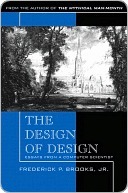More on this book
Community
Kindle Notes & Highlights
Read between
March 8, 2018 - October 20, 2024
Mediocre design provably wastes the world’s resources,
a design (noun) is a created object, preliminary to and related to the thing being designed, but distinct from it.
Unity of concept is the goal; it is achieved only by much conversation.
A chief service of a designer is helping clients discover what they want designed.
Requirements proliferation must be fought, by both birth control and infanticide.
sense of urgency, replaced with ever-increasing layers of “oversight”
need to communicate
academic instruction
substitute a less misleading model, not merely to augment present practice with a better model.
Creative design seems more to be a matter of developing and refining together both the formulation of a problem and ideas for a solution, with constant iteration of analysis, synthesis and evaluation processes between the two notional design ‘spaces’—problem space and solution space.
conceptual integrity is the most important consideration in system design.
orthogonality, propriety, and generality.
it is the architect who must bring professional technology mastery to bear for the users’ overall, long-run interest.
choose, fuse, or strike off in some third direction.
The fantasy concept has no function for originating designs, only refining them.
Schedule gain from collaboration implies concurrent activity; and concurrent activity requires synchronization,
monumental unconcern about conceptual integrity.
If collaboration tools are designed so they encourage committee design, they will do more harm than good.
Conceptual Design, Especially, Must Not Be Collaborative
The typical dynamics of two-person design collaboration seem different from those of multi-person design and solo design. Two people will interchange ideas rapidly and informally, with neither a protocol as to who has the floor nor domination by one partner. Each holds the floor for short bursts. The process switches rapidly among micro-sessions of proposal, review and critique, counterproposal, synthesis, and resolution. There is typically a single thread of idea development, without the maintenance of separate individual threads of thought as in multi-person discussions. Two pencils may move
...more
Perhaps the very need to articulate one’s thinking—
causes quicker perception of one’s own fallacies and quicker recognition of other viable design alternatives.
Pair-wise design sessions still need to be interspersed with solo ones—to detail, to document the creative fruit, and to prepare proposals for the next joint session.
No amount of collaboration eliminates the need for the “dreariness of labor and the loneliness of thought.”
Moreover, the distribution per se creates a lot of extra work!
2020 April 23 - we’re still learning remote work after a month of quarantine.
I think I could use the remote situation to insist on a little bit more structure.
We could definitely use it as justification of the extra refinement meeting we had yesterday.


